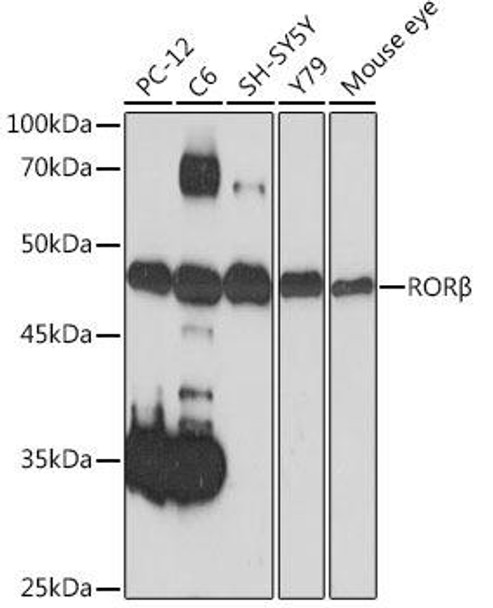Description
| Product Name: | ROR? Rabbit mAb |
| Product Code: | CAB19753 |
| Size: | 20uL, 50uL, 100uL |
| Synonyms: | NR1F2, ROR-BETA, RZR-BETA, RZRB, bA133M9.1 |
| Applications: | WB |
| Reactivity: | Human, Mouse, Rat |
| Host Species: | Rabbit |
| Immunogen: | A synthesized peptide derived from human ROR? |
| Applications: | WB |
| Recommended Dilutions: | WB 1:500 - 1:2000 |
| Reactivity: | Human, Mouse, Rat |
| Positive Samples: | PC-12, C6, SH-SY5Y, Y79, Mouse eye |
| Immunogen: | A synthesized peptide derived from human ROR? |
| Purification Method: | Affinity purification |
| Storage: | Store at -20°C. Avoid freeze / thaw cycles. Buffer: PBS with 0.02% sodium azide, 0.05% BSA, 50% glycerol, pH7.3. |
| Isotype: | IgG |
| Sequence: | Email for sequence |
| Gene ID: | 6096 |
| Uniprot: | Q92753 |
| Calculated MW: | 53kDa |
| Observed MW: | 53KDa |
| UniProt Protein Function: | RORB: Orphan nuclear receptor required for normal postnatal development of rod and cone photoreceptor cells. Regulates transcription of OPN1SW in cone photoreceptor cells by binding the sequence 5'-AGGTCA-3' in the OPN1SW promoter. Belongs to the nuclear hormone receptor family. NR1 subfamily. 2 isoforms of the human protein are produced by alternative splicing.Protein type: DNA-binding; Nuclear receptorChromosomal Location of Human Ortholog: 9q22Cellular Component: nucleoplasm; nucleusMolecular Function: ligand-dependent nuclear receptor activity; protein binding; zinc ion binding; sequence-specific DNA binding; steroid hormone receptor activity; transcription factor activity; transcription factor bindingBiological Process: transcription initiation from RNA polymerase II promoter; retinal rod cell development; intracellular receptor-mediated signaling pathway; positive regulation of transcription, DNA-dependent; rhythmic process; regulation of circadian rhythm; eye photoreceptor cell development; regulation of transcription, DNA-dependent; visual perception; retinal cone cell development; retina development in camera-type eye; negative regulation of osteoblast differentiation; gene expression; steroid hormone mediated signaling; negative regulation of transcription, DNA-dependent |
| UniProt Protein Details: | |
| NCBI Summary: | The protein encoded by this gene is a member of the NR1 subfamily of nuclear hormone receptors. It is a DNA-binding protein that can bind as a monomer or as a homodimer to hormone response elements upstream of several genes to enhance the expression of those genes. The encoded protein has been shown to interact with NM23-2, a nucleoside diphosphate kinase involved in organogenesis and differentiation, and to help regulate the expression of some genes involved in circadian rhythm. [provided by RefSeq, Feb 2014] |
| UniProt Code: | Q92753 |
| NCBI GenInfo Identifier: | 124028630 |
| NCBI Gene ID: | 124028630 |
| NCBI Accession: | Q92753.3 |
| UniProt Secondary Accession: | Q92753,Q8WX73 |
| UniProt Related Accession: | Q92753 |
| Molecular Weight: | 53220 |
| NCBI Full Name: | Nuclear receptor ROR-beta |
| NCBI Synonym Full Names: | |
| NCBI Official Symbol: | |
| NCBI Official Synonym Symbols: | |
| NCBI Protein Information: | |
| UniProt Protein Name: | Nuclear receptor ROR-beta |
| UniProt Synonym Protein Names: | Nuclear receptor RZR-beta; Nuclear receptor subfamily 1 group F member 2; Retinoid-related orphan receptor-beta |
| Protein Family: | Nuclear receptor |
| UniProt Gene Name: | RORB |
| UniProt Entry Name: | RORB_HUMAN |






